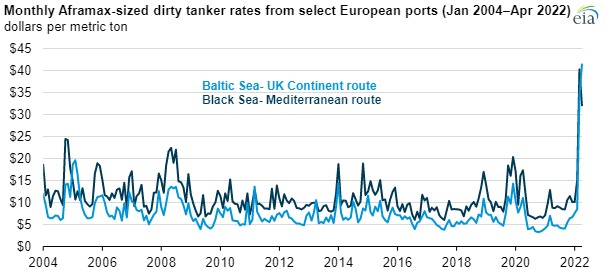New York May 26 2022: Petroleum tanker rates for routes originating in Europe rose to record highs in April 2022 because of geopolitical instability related to Russia’s full-scale invasion of Ukraine and rising marine fuel prices, also known as bunker fuel.
Dirty tanker rates for Aframax-sized vessels originating in the Black Sea in southeast Europe increased to $32.10 per metric ton (mt) in April 2022, more than triple the $10.11/mt price in January 2022. The tanker rates for routes originating in the Baltic Sea in northern Europe reached $41.38/mt in April 2022, up from $7.50/mt in January 2022.
Petroleum tankers are generally classified into two groups: clean tankers and dirty tankers. Clean tankers carry lower-sulfur petroleum products, including refined petroleum products such as motor gasoline, diesel fuel, jet fuel, and naphtha. Dirty tankers mostly carry crude oil, but they can also haul high-sulfur petroleum products such as residual fuel oil.
The high-cost tanker rates in the Black Sea include higher insurance risk premiums because the sea borders Ukraine and Russia. The Black Sea also borders Georgia, Turkey, Bulgaria, and Romania. One cause for the high Aframax rates at Russia’s Baltic Sea port, Primorsk, could be higher demand for the smaller Aframax ships on routes traveling from Russian ports to China. Normally, Very Large Crude Carriers (VLCCs) transport Russia’s Ural crude oil to China.
Because fewer Aframax ships are available globally, the dirty tanker rate for the Baltic-UK Continent (UKC) route increased from $8.53/mt in January 2022 to $41.38/mt in April 2022. Sanctions on Russia’s energy and maritime shipping sectors have caused crude oil buyers in Europe to purchase their crude oil imports from other markets. Weekly U.S. crude oil exports have been above the five-year range since the week of April 15.
Increased bunker fuel costs affect all tanker rates. Bunker fuel powers the motor on marine vessels, and the fuel can have varying levels of sulfur content. Between January and April 2022, bunker fuel prices for high-sulfur fuel oil (HSFO) increased by 28%, and prices for very-low sulfur fuel oil (VLSFO) increased by 33%.
VLSFO is a marine fuel that meets the International Maritime Organization’s 2020 regulations (IMO2020), which limit the sulfur content in marine fuels to 0.5% by weight from the previous limit of 3.5% (established in 2012) for ocean-going vessels. If ship owners do not want to pay the price premium for VLSFO, they can choose to install a scrubber, which allows the ship to use cheaper HSFO. A scrubber can cost $2 million to $6 million to install, depending on vessel type, size, and whether it is a retrofit or new build, which can make it cost prohibitive. The current price premium of VLSFO over HSFO increased to $276/mt in March 2022—the highest monthly spread since IMO2020 was implemented in January 2020.










